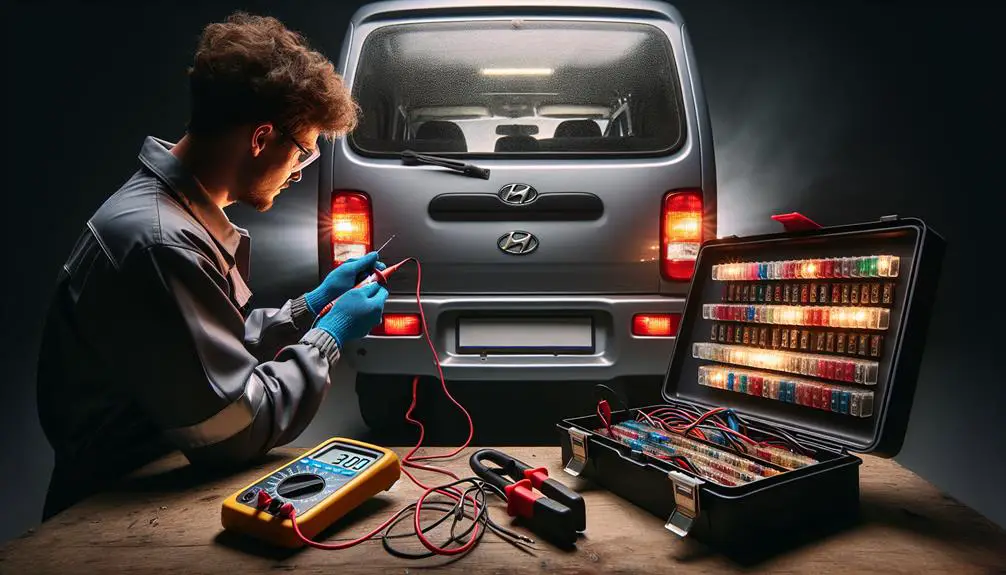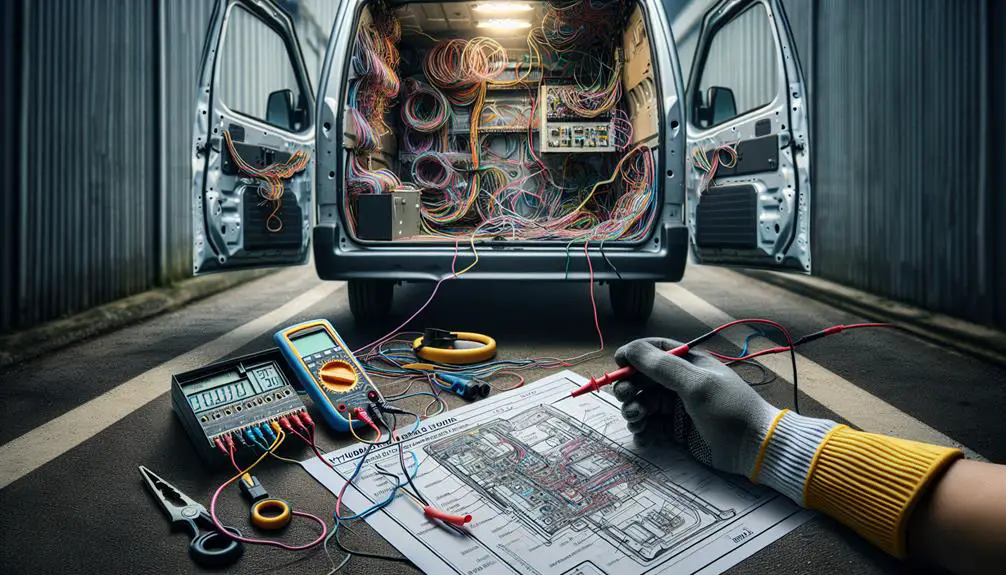To fix non-functioning brake lights on your Hyundai H100, follow these steps:
- Check and replace blown fuses.
- Check and replace faulty bulbs.
- Test the brake light switch.
- If the issue persists, inspect the wiring for any faults.
Identifying the Problem

Why are your Hyundai H100's brake lights not working? You've probably found yourself in a situation where pressing the brake pedal doesn't activate the brake lights. Before diving into more complex solutions, let's start with the basics. The issue often boils down to a few common culprits outside the fuse box, which you'll need to check.
First off, the problem might lie with the brake light bulbs themselves. Over time, bulbs can burn out or become disconnected. You'll want to inspect each brake light bulb. If they look cloudy, are visibly damaged, or don't light up when the brake pedal is pressed, it's time to replace them. Remember, it's always a good idea to replace bulbs in pairs to ensure consistent brightness and color.
Next, consider the brake light switch. This switch is what signals your brake lights to illuminate when you press the pedal. Located near the top of the brake pedal arm, it can sometimes become misaligned or fail entirely. If you're comfortable with a bit of DIY, you can check this switch by looking for any signs of physical damage or by using a multimeter to test for continuity. If the switch isn't working as it should, replacing it's usually straightforward and won't cost a lot.
Addressing these common issues can often resolve your brake light woes without needing to delve deeper into your vehicle's electrical system. Always start with the simplest solutions – they're often the right ones.
Checking the Fuse Box
After checking the brake light bulbs and switch, it's time to inspect the fuse box for any blown fuses that might be causing your Hyundai H100's brake lights to malfunction.
Initially, you'll need to find the fuse box. In most Hyundai H100 models, it's located under the dashboard on the driver's side or near the engine compartment. Your owner's manual can provide the exact location if you're unsure.
Once you've located the fuse box, open it up. You're looking for the fuse that controls the brake lights. This information is typically found on the fuse box cover or in the owner's manual. It'll tell you which fuse is for the brake lights and what color or number to look for.
Now, it's time to inspect the fuse. A blown fuse is usually easy to spot. The metal wire inside the plastic casing will be broken or appear burnt. If you're having trouble seeing it, you might want to use a small flashlight.
If you detect a blown fuse, don't rush to replace it just yet. It's essential to understand that fuses blow for a reason – often because of a short circuit or an overload in the system. Replacing a blown fuse without addressing the underlying issue could result in the new fuse blowing as well.
Replacing Brake Light Bulbs

Before you proceed with replacing the brake light bulbs in your Hyundai H100, make sure you've purchased the correct replacements by consulting your vehicle's manual. It's important to choose the right bulbs to make sure they fit perfectly and function as intended. Replacing the brake light bulbs might seem challenging, but it's a straightforward process you can do with just a few tools.
Here's how to get it done:
- Turn Off Your Vehicle: Make sure your H100 is turned off and parked on a level surface. It's a safety precaution to prevent any electrical issues while you're working on the lights.
- Access the Brake Light Assembly: Open the rear door or tailgate of your H100 to access the brake light assembly. In most cases, you'll find the brake light housing attached with screws or clips. Use a screwdriver or a suitable tool to carefully remove these fasteners and gain access to the bulbs.
- Replace the Bulbs: Once you have access, remove the faulty bulb by gently twisting it counter-clockwise and pull it out of the socket. Take your new bulb (that you've verified is the correct type for your H100) and insert it into the socket. Twist it clockwise to secure it in place. Make sure it's fitted properly and there's no wiggle room.
After you've replaced the bulbs, reattach the brake light assembly and make sure it's securely fastened. It's a good idea to test the lights to make sure they're working correctly before you hit the road again. Remember, proper maintenance and timely replacement of your brake light bulbs can greatly improve your road safety.
Testing the Brake Light Switch
Having replaced the brake light bulbs in your Hyundai H100, it's also essential to check the brake light switch to make sure it's functioning correctly. This switch is what signals your brake lights to illuminate when you press the brake pedal. If it's faulty, your brake lights won't work, even with new bulbs.
Initially, locate the brake light switch. You'll typically find it near the top of the brake pedal. It's a small, plunger-like device that engages when you press the pedal.
To test the switch, you'll need a multimeter set to the Ohms (Ω) setting. Disconnect the switch from the wiring harness before you start. If you're not sure how to safely do this, consult your vehicle's repair manual or an online guide for specifics.
With your multimeter, test for continuity by placing one probe on each terminal of the switch. With the brake pedal released, the multimeter should show no continuity. When you press the pedal, the switch activates, and your multimeter should indicate continuity. If it doesn't change state between pressed and released, the switch isn't working properly.
If the switch tests bad, you'll need to replace it. They're generally affordable and easy to replace. Make sure the new one is properly aligned and securely connected. After replacement, test your brake lights again.
Troubleshooting Wiring Issues

If your Hyundai H100's brake lights still aren't working even with a functional brake light switch, it's time to investigate the wiring system for potential issues. Wiring problems can be tricky, but with a systematic approach, you'll find and fix the issue in no time.
Here's how to get started:
- Check for Visible Damage
- Start by inspecting the wiring harness that connects to the brake lights. Look for any visible signs of damage, such as frayed wires, corrosion, or anything that seems out of place. Sometimes, the problem is as simple as a wire that's come loose or has been damaged by wear and tear.
- Test for Continuity
- Grab a multimeter and set it to the continuity setting. Disconnect the wiring harness from the brake lights and touch one probe to one end of a wire and the other probe to the opposite end. If the multimeter beeps or shows a reading, that wire is good. If not, you've found your culprit. Repeat this process for each wire until you've checked them all.
- Inspect Ground Connections
- A faulty ground connection can often cause brake lights to malfunction. Check the ground wire that's connected to the brake light assembly. Make sure it's securely attached and free of corrosion. If it looks suspect, clean the connection point or replace the wire as needed.
Conclusion
In wrapping up, you've tackled the common culprits behind your Hyundai H100's brake light woes. From checking the fuse box, replacing old bulbs, to testing the brake light switch, and even working through annoying wiring issues, you've covered all bases.
Remember, maintaining these lights isn't just about compliance; it's essential for safety. If you're still stuck, don't hesitate to consult a professional. Safe driving starts with functioning brake lights, and you're now well-equipped to make sure they're always in top shape.